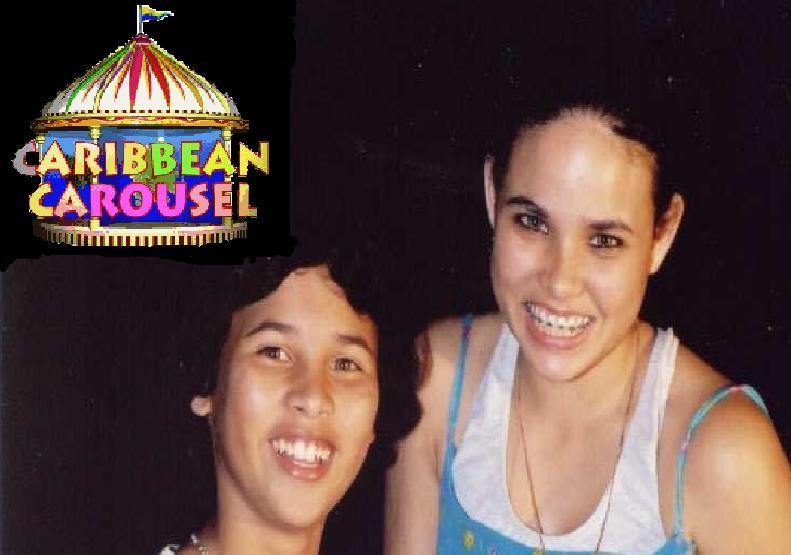
THE CONVICTED FELON
The only other known survivor in
St. Pierre became a minor celebrity. He was a husky 25-year-old roustabout
named Louis-Auguste Cyparis, locally known simply as "Samson".
In early
April, Samson was put in jail for wounding one of his friends with a
cutlass. Towards the end of his sentence, he escaped from a labouring job
in town, danced all night, and then turned himself into the authorities
the following morning. For this, he was sentenced to solitary confinement
for a week in the prison's dungeon.
On May 8, he was alone in his dungeon
with only a small grated opening cut into the wall above the door. While
waiting for his breakfast, his cell became dark and he was overcome by
intense gusts of hot air mixed with ash that had entered through the
grated opening. He held his breath while experiencing intense pain. After
a few moments, the heat subsided. He was severally burned, but managed to
survive for four days before he was rescued by people exploring the ruins
of St. Pierre.
After he recovered, he received a pardon and eventually
joined the Barnum & Bailey Circus, where he toured the world billed as
the "Lone Survivor of St. Pierre."
THE SHOEMAKER
A young shoemaker,
Léon Compere-Léandre, was sitting on his doorstep when the nuée ardente
hit. Although he was severely burnt he survived, partly because of his
good health, but also because his house was near the edge of the
pyroclastic flow.
"I felt a terrible wind blowing, the earth began to
tremble, and the sky suddenly became dark. I turned to go into the house,
with great difficulty climbed the three or four steps to my room, and felt
my arms and legs burning, and body. I dropped upon a table.
At this moment
four others sought refuge in my room, crying and writhing with pain,
although their garments showed no sign of having been touched by flame. At
the end of 10 minutes one of these, the young Delavaud girl, aged about 10
years, fell dead; the others left. I got up and went to another room,
where I found the father Delavaud, still clothed and lying on the bed,
dead. He was purple and inflated, but the clothing was intact.
Crazed and
almost overcome, I threw myself on a bed, inert and awaiting death. My
senses returned to me in perhaps an hour, when I beheld the roof burning.
With sufficient strength left, my legs bleeding and covered with burns, I
ran to Fonds-Sait-Denis, six kilometres from St. Pierre."
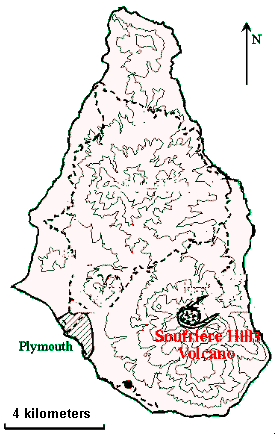
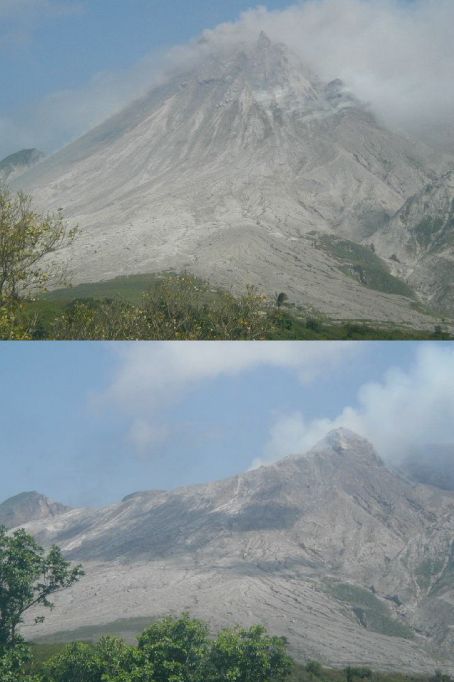
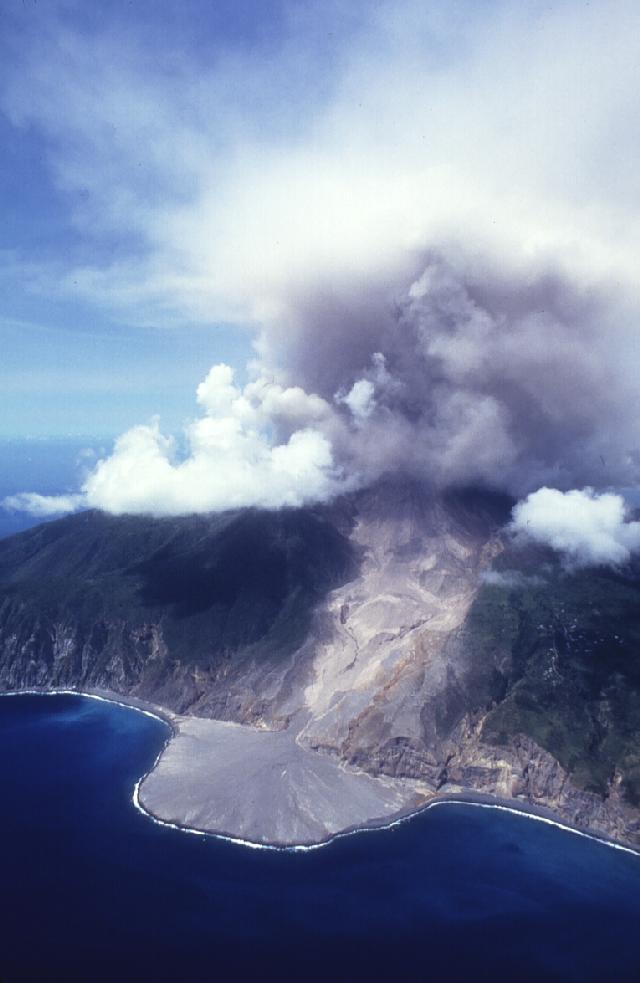
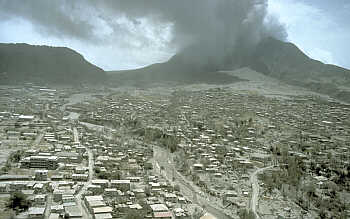
|
The Soufriere Hills volcano on the island of Montserrat, began erupting on July 18 1995,this is the first recorded eruption in historic times. A puff of ash announced to the residents that after millennia of slumber, the island's dominant landmark, the Soufriere Hills volcano, had come to life. Over the following days, repeated steam explosions accompanied by ashfalls and earthquake swarms raised the possibility that a major eruption might be imminent.
By August 8, officials evacuated the sick and elderly from the southern half of the island. On August 21, a strong burst of steam carried a cloud of ash to an altitude of 7,000 feet, plunging the capital city of Plymouth into darkness.
The steam rising above the old volcano is for the most part multi-million-year-old ocean water.
After the scare of August 21, the Soufriere Hills volcano settled down to a routine of hissings and rumblings that continue to the present. |
Make your own erupting Volcanoes of the Caribbean
|
In a real volcano, molten rock from deep within the Earth erupts through a
volcano (the molten rock is called magma when it is within the Earth and is
called lava when it comes out of a volcano).
Warning:
Be careful when handling ingredients.
Children should be supervised by
an adult.
Ingredients should be kept away from the eyes.
Supplies:
- Old plate or baking pan or paper plate
- Lots of old newspaper
- Baking soda (about 3-4 tablespoons)
- Vinegar (about 1/2 cup)
- A few drops of liquid dishwashing detergent
- Small plastic bottle (like a small pop bottle)
- Modeling clay(Play Dough)
- Funnel
- Measuring spoon and measuring cup
- Red and yellow food coloring
- Glitter (optional)
|
|
Your volcano can be made more realistic by enclosing the
bottle in a home made play dough.
Mix 6 cups of flour, 2 cups of salt, 4 tablespoons of
cooking oil, and 2 cups of water in a large bowl.
Mix the ingredients by hand until smooth and firm. Add
more water to make the mixture if necessary.
Build up the mixture around the drink bottle to create
the mountain.
Lava channels and vegetation can be built around the
volcano. Using the modeling clay, make a volcano around the bottle. Leave the
area around the top of the bottle open and don't get any clay inside the
bottle.
You can decorate the volcano with little twigs, lichens (that look like
tiny trees), etc. |
1/Put the clean, empty bottle on the plate
or baking pan or paper plate.
| 2/Using the funnel (make sure it's dry), put 3 to 4
tablespoons of baking soda into the bottle.
3/The add a few drops of liquid
dishwashing detergent and about a half cup of water. Optional: add a
little bit of glitter (about half a teaspoon). |
4/Put a few drops of red food coloring into about one-half
of a cup of vinegar. | |
This happens because of the baking soda and vinegar mixture. Mixing baking soda and vinegar produces a
chemical reaction (a chemical reaction is a process in which one substance is chemically converted to another -
all chemical reactions involve the formation or destruction of bonds between atoms) in which carbon dioxide gas
is created - the same gas that bubbles in a real volcano. The gas bubbles build in the bottle, forcing the
liquid 'lava' mixture of the bottle and down the sides of your volcano


